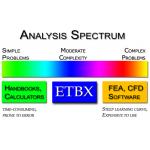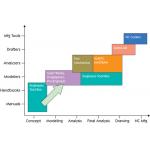The Engineers Tool Box
Here's a look at a little known analysis software package that strivesto bridge the gap between reference materials and high-end applications.
Latest News
August 1, 2005
By Austin Kozman
| Here’s a look at a little known analysis software package that strives to bridge the gap between reference materials and high-end applications. In today’s world, multidisciplinary expertise is required to solve engineering problems. For example, to determine what caused a failure in a device or a piece of equipment, an engineer must understand the load generation mechanism. These loads can be generated by many variables, including fluid flow, heat, material fatigue, stress, and strain. And to accurately estimate the loading in such failures, an understanding of the behavior of these variables is required. An engineer might need to know how stresses lead to physical breakage or how thermal characteristics caused an electronic circuit to melt. To solve such problems the engineer is often required to perform calculations involving fluid flow, heat transfer, solid mechanics, dynamics, fatigue, and fracture mechanics. And the challenge is similar during the initial design phase of a device or when evaluating a product or piece of equipment. The analysis techniques available to design and analysis engineers are quite varied. At one end of the spectrum are detailed analysis computational tools like computational fluid dynamics (CFD) and finite element analysis (FEA); at the other are the hand-held calculator and reference books. In between is a large gap in the levels of complexity, detail, and rigor associated with the tools. The mid region of the spectrum is sparsely populated with in-house software, special purpose calculations, and personal preference calculation spreadsheets. These mid-level tools are not generally available or accessible to the engineer. A spread-sheet calculation created by one engineer usually isn’t shared with other engineers, even within the same organization. And even when they are shared, these calculators are not user-friendly and include little or no documentation.
At the other end of the spectrum, very often, simplified calculations based on first principles or correlations are applied to estimate the expected behavior of a device. These calculations also serve to eliminate the possibility of user error during the application of complex tools like CFD and FEA). At times, it is essential to carry out simplified calculations prior to performing a detailed CFD or FEA analysis. For the simplified calculations the engineer uses a hand calculator, reference books, and at times spreadsheet calculators. In these cases, an appreciable amount of time is spent in sifting through reference material the engineer knows about and has access to, and in checking calculations. There is a clear need to bridge the gulf between the tools at the two ends of our analysis spectrum. Semi-automated tools that can perform a range of analysis calculations varying from the simple to the moderately complex are the answer. An intuitive software package called the EngineersToolbox (ETBX) enables the engineer to interactively explore solutions to typical engineering systems and scenarios and serves to help bridge the void (see Figure 1). ETBX, which was launched as a Web-based tool in 2001, is a product of Engrasp Inc. of Arlington, TX, and includes integrated computational modules designed to rapidly solve typical engineering systems and scenarios.
Toolbox Basics The current version of ETBX covers a comprehensive range of engineering specialties, including solid mechanics, dynamics and controls, fatigue and fracture mechanics, fluid mechanics, heat transfer, numerical methods, and engineering reference utilities. It’s a knowledge vault that would take years of practice and experience to otherwise collect, and ETBX delivers this expertise and body of knowledge in an easy-to-use format to the engineers desk. ETBX solution types include static deflection and stress calculations, natural frequencies and mode shapes, dynamics of linear and nonlinear systems, transient, frequency response, flow rate, pressure drop, and heat transfer computations. For example, consider the design of an automobile structural component as carried out using ETBX. The load-bearing member consists of an open-section bar. ETBX is used to examine the structural behavior of various bar cross-sections as depicted in Figure 3. The static deflections under prescribed loads are rapidly computed for various cross-sections and sizes as depicted in Figure 4. This allows rapid optimization of the bar shape and size.
Common physical systems such as columns, beams, helical springs, interference fit, and pressure vessels can be analyzed at the click of a button. Static deflections, stresses, shears, moments, natural frequencies, mode shapes, dynamic linear, and nonlinear system response can be computed for selected systems. And fluid flow and thermal modules can be applied to compute flow behavior and heat transfer coefficients in predefined shapes. The numerical analysis modules include a polynomial root solver, matrix inverter, and a function plotter; and the tool includes a comprehensive materials database and units converter. That means calculations can be performed in any set of user-defined units.
Solutions computed in ETBX modules can be easily transferred and data exchanged between modules, and online documentation provides a comprehensive description of the solution methods. The results can be exported to various formats and its dynamic visualization capabilities can be applied to animate and view deformations in the system. Austin Kozman, Ph.D. is vice president and a founding member of Engrasp, Inc. Kozman received his B.S.M.E., M.E., and Ph.D. in mechanical engineering from the University of Texas at Arlington. He’s been issued a US patent and has three pending. In 1999, Kozman was selected the Young Engineer of the Year by the North Texas Electronic Packaging Division of ASME. He has many years of experience in thermal and mechanical design. His work incorporates finite element analysis, computational fluid dynamics thermal modeling, analytical calculations, and empirical experimental studies to optimize the combustion and bake efficiency of ovens. You can send him an e-mail about this article by clicking here. Please reference ETBX September 2005 in your e-mail. | |||||||||||
Subscribe to our FREE magazine, FREE email newsletters or both!
Latest News
About the Author
DE’s editors contribute news and new product announcements to Digital Engineering.
Press releases may be sent to them via [email protected].











